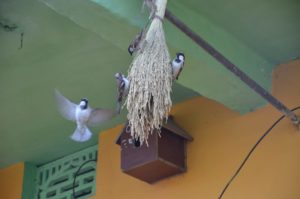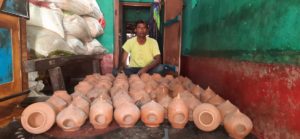Save House Sparrow Campaign Sees Bird’s 10-Time Population Growth In Odisha’s Gopalpur

Berhampur: A mission for protection and conservation of house sparrows, popularly known as ‘Ghara Chatia’, is gaining momentum in tourist spot Gopalpur of Ganjam district.
The Rushikulya Marine Turtle Protection Committee (RMPTC), a voluntary organisation comprising youths of Purunabandh village in Ganjam block, continues to conserve the house sparrow in Gopalpur since 2014. The organisation, which is also working for the protection of endangered Olive Ridley turtles for the last 27 years, is engaged in creating artificial nests for the birds for reproduction.
“We have placed more than 300 artificial nests made of earthen pots, plywood and hardboard in the verandah or any appropriate place of houses to support reproduction of house sparrow in Gopalpur and another 500 artificial nests are on the pipeline,” said Rabindranath Sahu, secretary RMPTC.
Stating that they are providing artificial nests to the interested families free of cost, Sahu said they launched the mission in Gopalpur on August 1, 2014 when there were only 200 house sparrows. “During the last seven years, the sparrows’ population has increased ten times to 2000,” said Sahu, who is now working in 11 districts of Odisha to support conservation and reproduction of house sparrows.
RMPTC launched the house sparrow campaign in Purunabandha in 2007 when the population of the birds had dwindled to only seven. Now their number has increased to more than 400, said Sahu who received the House Sparrow Award instituted by ‘WIPRO’ and Nature for Ever Society in 2015. The award carried Rs 50,000 as prize money.
“Since there is no financial support from the state or the Union government, I have spent all the prize money and donation amounts from other sources for making the artificial nests. More than Rs 1 lakh has been spent only in Gopalpur,” Sahu said.
The bird lover, who has closely studied the behaviour of the house sparrow, said its main diet consists of grain, especially waste grain and livestock feed. But they can adapt to any diet, if grain is not available. They also eat weeds and insects, especially during the breeding season.

These birds usually prefer roofs of thatched or pucca houses for roosting, nesting and cover and want to remain closely associated with human habitation. The ecological imbalance in today’s fast changing world poses a threat to the existence of house sparrows, he said.
Earlier, nesting was not a problem as every house used to have a backyard and enough greenery to attract these species. Now, with the concrete jungle emerging everywhere including the villages, these birds hardly find space to build their nests.
Sahu claimed that encroachment of green space, use of insecticides and pesticides, increase in pollution levels and radiation from cell phone towers have seriously affected the reproduction of these birds.

“Sparrows are very social birds and tend to flock together most of the year. A flock’s range covers 1.5-2 miles, but it can extend the territory if necessary for food. A normal sparrow has a length of 14-16 cm and a wing span of 19-25 cm. It is a small, stocky song bird that weighs 26 to 32 gram.
According to ornithologists, the male sparrow has a grey crown, cheeks and is black at throat, upper breast and between the bill and eyes. But the bill in summer changes to blue black and the legs brown. In winter, pale edgings dull the plumage, and the bill becomes yellowish brown. The female has no black colour on the head or throat. A grey crown on her upper part is streaked with brown and the juveniles are deeper brown and the white is replaced by beige, the beak is dull yellow.

Comments are closed.